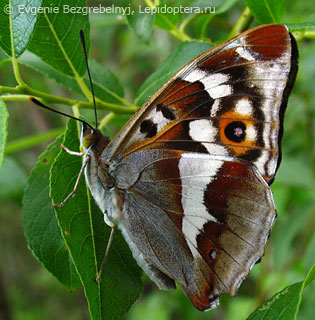Apatura iris

Taxonomy
class Insecta
Species name(s)
Apatura iris (Linnaeus, 1758) = Papilio iris Linnaeus, 1758 = suspirans (Poda, 1761) = junonia (Borkhausen, 1788) = rubescens (Esper, 1781) = Apatura pallas Leech, 1890 = Papilio beroe Fabricius, 1793 = Chitoria pallas = Apatura lutescens Schultz 1904 = Apatura pseudoiris Verity 1913 = Apatura salicis Fabricius 1807 = Papilio suspirans Poda, 1764. [9, 10, 187]
Purple Emperor.
urn:lsid:insecta.pro:taxonomy:8544
Expansion
This species marks on the maps: 4.
Zoogeographical regions
Palaearctic.
Russia regions
#1. Kaliningradsky; #3. Karelsky; #4. Evropeisky Severo-Zapadny; #7. Evropeisky yuzhno-tayozhny; #8. Evropeisky Tsentralny; #9. Evropeisky Tsentralno-Chernozyomny; #10. Sredne-Volzhsky; #11. Volgo-Donsky; #16. Sredne-Uralsky; #17. Yuzhno-Uralsky; #19. Sredneobsky; #20. Yuzhno-Zapadnosibirsky; #22. Krasnoyarsky; #23. Predaltaisky; #24. Gorno-Altaisky; #25. Tuvinsky; #26. Predbaikalsky; #27. Pribaikalsky; #28. Zabaikalsky; #36. Sredne-Amursky; #37. Nizhne-Amursky; #40. Primorsky.
Forewing length
28—32 mm.
Wingspan
60—70 mm.
Primary colors
Blue, Brown/Gray/Black, White, Irisated.
Flight time
| January | February | March | April | May | June | July | August | September | October | November | December |
Larva lifespan
| January | February | March | April | May | June | July | August | September | October | November | December |
Over-wintering stage
Larva.

Detailed information with references
Distribution
Imago Habitus and Differences from alike species
General info about Imago
Imago lifespan
General info about Larva
Larva food plants / other food objects
Larva lifespan
Pupa
Egg
Overwintering stage
Subspecies of Apatura iris
- Apatura iris afflicta Cabeau, 1910. [187]
- A. i. agathina Oberthür. [187]
- A. i. amurensis Stichel, [1909]. [9]
- A. i. atava Verity, 1950. [187]
- A. i. aurosquamosa Gillmer, 1905. [187]
- A. i. bieti Oberthür, 1885. [9]
- A. i. bureana Cabeau, 1910. [187]
- A. i. cerberea Cabeau, 1919. [187]
- A. i. corax Cabeau, 1910. [187]
- A. i. deschangei Cabeau, 1910. [187]
- A. i. diaphona (Lambillion) & Cabeau, 1910. [187]
- A. i. dimeres Cabeau, 1919. [187]
- A. i. flavomaculata Kollar, 1909. [187]
- A. i. hindenburgi Mecke, 1926. [187]
- A. i. interfracta Cabeau, 1930. [187]
- A. i. iolata Cabeau, 1910. [187]
- A. i. iriella Lambillion & Cabeau, 1910. [187]
- A. i. jole Denis & Schiffermüller, 1776. [187]
- A. i. junonina (Lambillion) & Cabeau, 1910. [187]
- A. i. kansuensis O. Bang-Haas, 1933. [9]
- A. i. lacustris Rocci, 1930. [187]
- A. i. likiangensis Mell, 1952. [187]
- A. i. lugenda Cabeau, 1910. [187]
- A. i. monophana Cabeau, 1919. [187]
- A. i. moriei Le Moult, 1947. [187]
- A. i. obscura Sälzl, 1923. [187]
- A. i. pallida Osthelder, 1925. [187]
- A. i. penumbrata Cabeau, 1919. [187]
- A. i. perlinaghia Turati, 1927. [187]
- A. i. recidiva Stichel, 1908. [187]
- A. i. romaniszyni Schille, 1924. [187]
- A. i. stictica Cabeau, 1910. [187]
- A. i. strandi Biezanko, 1924. [187]
- A. i. tetrica Cabeau, 1910. [187]
- A. i. thaumantias Cabeau, 1910. [187]
- A. i. thaumantis Schultz, 1903. [187]
- A. i. transtenuata Cabeau, 1919. [187]
- A. i. vidua Cabea, 1910. [187]
- A. i. viridana Cabeau, 1919. [187]
- A. i. xanthina Oberthür, 1909. [9]
Authors
Initial species uploading to the site: Peter Khramov.
Text data: Peter Khramov, Vasiliy Feoktistov.
The species characteristics formalization: Peter Khramov, Sergei Kotov, Vasiliy Feoktistov.
References
- [1] O. Karsholt, J. Razowski (eds.), 1996. The Lepidoptera of Europe: a distributional checklist
- [3] Каталог чешуекрылых (Lepidoptera) России. Под ред. С. Ю. Синёва. СПб.; М.: Товарищество научных изданий КМК, 2008
- [9] Tree of Life (funet.fi), 2012
- [10] de Jong, Y.S.D.M. (ed.) (2011) Fauna Europaea version 2.4 (faunaeur.org)
- [28] Moths and Butterflies of Europe and North Africa (leps.it), 2012
- [85] Lepidoptera species catalogue, Lepidoptera.ru, 2015
- [148] Б.М. Мамаев, Л.Н. Медведев, Ф.Н. Правдин. Определитель насекомых европейской части СССР . Москва, " Просвещение" 1976
- [187] Species 2000, http://www.sp2000.org
Comments
Note: you should have a Insecta.pro account to upload new topics and comments. Please, create an account or log in to add comments
Apatura iris photos







































All the photos of the species in large size
Please, create an account or log in to upload your photo



